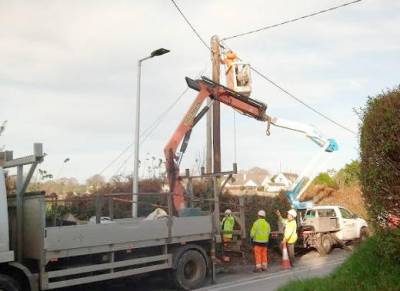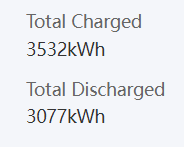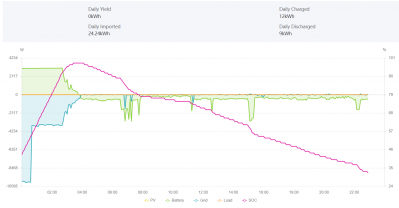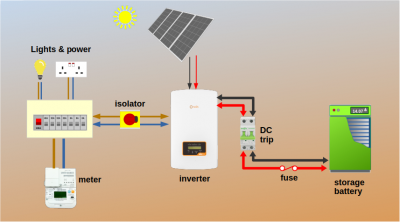The Sunsynk hybrid inverter is a great choice, but there are other less expensive ones - for example I had a Sofar ME3000SP which you can pick up a pre used for a few hundred pounds from eBay.
I had a Sofar but changed for a Sunsynk 5kw because I have a limited cheap rate time of use (4 hours) so needed an inverter that could charge my battery a lot faster.
In hindsight I should have got an 8kw BUT I got it really cheap so I can always add another 5kw Sunsynk inverter if I really needed it.
Posted by: @transparentOK. Understood. So you will require a G98 certified inverter because it's grid-tied.
And you'll want one with a Current Transformer (CT) which is configured to prevent all export.
Whatever is stored in the battery will only get used within your house.Have you considered a SunSynk 'Bi-directional' inverter?
They are designed to permit no export to the grid by default.
Moreover that export-limitation mechanism already has approval by the ENA (Electrical Networks Association).
So you could opt for an inverter model with greater output than 16A, and still be granted approval from your DNO (which in your case is NIEN).You can verify this by applying online for G99F/T (Fast Track) permission, and stating a particular SunSynk model.
G99 applies to combined storage and export, and is explained more fully on that website.You don't then have to install that model. You can change your mind and apply again.
But at least that will give you an idea of any 'issues' which the DNO thinks might apply to your particular site.
Thanks for the suggestion, it looks to be an interesting device but is probably overkill for my application. In particular I have no need for PV capability and was looking for a G98 certified unit. G99 fast track in Northern Ireland seems to only apply to multiple G98 in parallel. (See the following)
I will call them next week to see if this interpretation is correct and whether a G99 certified device with export limitation is eligible for Fast Track.
Posted by: @misterbThe Sunsynk hybrid inverter is a great choice, but there are other less expensive ones - for example I had a Sofar ME3000SP which you can pick up a pre used for a few hundred pounds from eBay.
I had a Sofar but changed for a Sunsynk 5kw because I have a limited cheap rate time of use (4 hours) so needed an inverter that could charge my battery a lot faster.
In hindsight I should have got an 8kw BUT I got it really cheap so I can always add another 5kw Sunsynk inverter if I really needed it.
Thanks for the suggestion, this looks like a possibility. Most of the Ebay units seem to be "refurbished", Which does raise the questions of what was wrong with these units that resulted in so many being sent back for rework. It looks a bit strange to be honest.
I haven't come across a bi-directional inverter which does not have solar input @alphonsox
That bit of the electronics isn't a substantial part of the design, and I'd be surprised if there was enough of a market for that sort of unit.
The G-standards don't exactly fit your situation for the same reason.
Any device which is incorporated into a G99 installation would be G98 certified.
G99 evaluates the overall arrangement. Not having any form of on-site generation isn't a category.
The present base assumption is that any site which has grid-tied battery storage would also have solar/wind/hydro generation, and therefore export-limitation is required.
Please don't be daunted by making such an application. It's straightforward and you'll find the engineers are very helpful.
There is also a wider benefit in your site being G99 assessed.
The calculations reveal to the DNO what constraints exist for properties supplied from the same feed and substation transformer.
Local substations aren't monitored, so there's considerable value to the DNO in checking their status over time as G99 applications arrive from the public.
Sometimes it highlights a need to upgrade/replace a feed-cable, or possibly replace the entire transformer.
A G99 application I made 3 years ago instigated an upgrade of the pole-mounted 3-phase feed along the road to my house.
The new wires are ABC (Aerial Bundled Cabling) with a higher current-rating and lower maintenance requirements.
This upgrade did not hold up the inverter installation work at my house.
Moreover the Area Manager instructed his team to run 3-phase all the way to my house because there's a chance that I might want/need it in future.
There was no charge made for that common-sense approach.
Save energy... recycle electrons!
@transparent It is very refreshing to hear that common sense is employed in this way sometimes, I have no idea of the capacity of our local electrical supply; our services were I think laid in the 1930’s and though ‘patches’ are regularly being applied somewhere or other in the road every 4 to 6 months, I don’t think the capacity has been uprated since early days. My G99 application went through after some 12 weeks but no restraints or additional conditions were imposed so I suppose the capacity is adequate. My installer informed me that there are now limitations placed on my inport / export rates and the two Tesla Powerwall 2’s traffic up to 10 kW. Regards, Toodles.
Toodles, heats his home with cold draughts and cooks food with magnets.
@korwraith it’s been a while since your posted your detailed journey. How are things going with your system?
Get a copy of The Ultimate Guide to Heat Pumps
Subscribe and follow our YouTube channel!
@editor All good here! I'm happy to say that the system has been error free since setup, operating exactly as expected.
(My current 'lifetime' usage data since going live in March 2023)
Some reflections:
- Inverter Power Rating - I was a bit concerned that power usage might regularly exceed the 3kW output of the inverter I'd chosen but it rarely happens and doesn't add up to much when it does. Certainly, I wouldn't have ever have made the money back if I'd paid more for a 5kW inverter. A typical day for my system is as shown (the blue spikes on the negative X-axis indicate grid draw, it snapshots at 5 minute increments so the graph isn't 100% accurate):
-
- Winter - relatively mild this year, but even still I had to throw a blanket over my lightly insulated Seplos box to keep temperatures from going below 15'C within an internal garage
- Efficiency/Conversion Loss - I've charged 400kWh more than I've discharged, this gives a round trip efficiency of 87%. I casually experimented with the charging current over a few months and found the maximum charging current of 60A was a little less efficient than lower currents. I've settled on 45A as a middle ground between charging efficiency and charging speed (usually enough current to top back up to target except on exceptionally heavy use days that empty the battery).
- Money Stuff - since going live there's been around 20p difference between peak and off peak electricity. My maths says the battery has saved me £570 in the last 14-odd months. Unfortunately my purchase timing was quite unfortunate and batteries have significantly dropped in price during the last year, so theoretically at this stage I might have been better off not installing the system 🤣 . I expect (hope?) the situation will not be repeated in future years.
- Export - as a 99% self-installed system, I don't have MCS status which is a barrier to export income. Not something I expected to do when getting my battery, but this last winter saw forced discharge from batteries paying £2+/kWh during saving sessions. Presumably this will be a feature of the grid going forward and so I hope one way or another I may be able to become eligible for export at some point in the future...
So has it been worth it for me? Economically (which was my main motivation), so far, no.
HOWEVER - I learned a lot which will serve me in years to come and I enjoyed doing the project 😀
@korwraith congratulations on your project. I am also consider to do somethinf similar. I have a dumb question about the connection to realise your off peak charging and peak discharging from the bettery. I supposed you connect the grid after the smart meter with isolator to your inverter at the AC grid connection. This is how the battery will get charged in the off peak time. At the same time, the load connected to the consumer unit will also draw power from the grid. But when in the peak time and the battery discharge, will the power transmitted through the the same AC grid port to the consumer unit? Is there potential conflict between the grid and the inverter?
@howerpiece Our system has a Tesla Gateway and Powerwalls plus we have solar PV. The Gateway (programmed from the app using my iPad or iPhone) allows me to set times for charging the battery and whether the PV is used as the electrical supply, charges the battery but when no PV power is available, whether the battery supplies our needs or allows the grid to do so. The Tesla app can be set (manually) to align with Agile’s lowest priced intervals to charge the battery and normally, the grid only supplies power to the house load at the cheapest times or if the battery runs out (this has not happened yet but it has come close a few times.) Other systems may be configured differently but with the same options usually available. Regards, Toodles.
Toodles, heats his home with cold draughts and cooks food with magnets.
Posted by: @howerpiecein the peak time and the battery discharge, will the power transmitted through the the same AC grid port to the consumer unit? Is there potential conflict between the grid and the inverter?
No conflict @howerpiece
The inverter adjusts its mains output voltage so that the stored energy in the battery is used in preference to that available from the grid.
If the load(s) in the house require more current than can be offered by the inverter, then the balance is supplied from the grid.
The downside of this arrangement is that your regional Distribution Network Operator (DNO) is unlikely to allow the inverter to output more than 16A (3.68kW).
Save energy... recycle electrons!
@transparent @toodles Thanks for your replies. That is very clear. I recently have the EV charger installed, but I don't want the inverter to do anything with the EV charger. So for the CT in this case, I will install it after the live wire after the EV but before the inverter and the customer unit, right?
I might want to use a Growatt SPA3000 AC coupled inverter since Home Assistant already has an integration for that. I have a diagram from the manual. But of course, there will be a fuse added according to this thread. If I plan to add PV solar, is a hybrid inverter better?
Another question regarding the DNO. I believe this system is a 'single G98 generator connection', which I should apply through my energy networks, right?
I found a guidance there. https://www.spenergynetworks.co.uk/pages/single_g98_generator_connections.aspx. Where they require a form, a circuit diagram and SSEG test report. Is the diagram provided by the manual good enough?
Posted by: @howerpieceI might want to use a Growatt SPA3000 AC coupled inverter since Home Assistant already has an integration for that.
Yes-ish.
Please bear in mind that the standard Home Assistant integration for Growatt uses the Growatt API and provides very little functionality for actually changing config; it’s almost all centred around retrieving stats. Perhaps more importantly, Growatt themselves have been making regular changes to their API which either deliberately or incidentally have stopped third party access until the third party application - in this case the integration - is amended. In short, it’s unreliable.
On the other hand, choosing to cut out the middle man and use the Solax modbus integration along with a wire into one of the ports on the inverter has, for me, proven absolutely rock solid even when the Growatt app or website have been unavailable or the inverter hasn’t been able to talk back home.
If you need details, just shout. It’s a lot less scary than it might seem.
105 m2 bungalow in South East England
Mitsubishi Ecodan 8.5 kW air source heat pump
18 x 360W solar panels
1 x 6 kW GroWatt battery and SPH5000 inverter
1 x Myenergi Zappi
1 x VW ID3
Raised beds for home-grown veg and chickens for eggs
"Semper in excretia; sumus solum profundum variat"
- 26 Forums
- 2,360 Topics
- 53.5 K Posts
- 130 Online
- 6,026 Members
Join Us!
Worth Watching
Latest Posts
-
RE: Mitsubishi Ecodan R290 10kW performance
@sheriff-fatman This is the table that I am familiar wi...
By Ecoste , 3 hours ago
-

RE: My Powerwall 3 Consumes 3-4 kWh/Day in Self-Consumption: Is This Normal?
@caron, I'm looking into this for you... from my own pe...
By Mars , 5 hours ago
-
RE: New Fogstar 15.5kWh upright solution
SITREP #5 (I think) Milestone completed toda...
By GGW , 7 hours ago
-
RE: Octopus Cosy Heat Pump Owners & Discussion Thread
The FT levels off at either the set point OR the minimu...
By AndrewJ , 7 hours ago
-
RE: MyVaillant Connect Regular Disconnect
Thanks. Yes, if the time is consistently 11pm every nig...
By buckwem , 7 hours ago
-

RE: Speedcomfort radiator fans
My take on Speedcomfort radiator fans: If anyone w...
By Mars , 13 hours ago
-
RE: Midea ASHP – how to set weather compensation
@pash44pump I have yet to come across any Clivet or Mid...
By benson , 13 hours ago
-
RE: Who's your electricity provider and what's your tariff?
@transparent Thanks, this helps. Could it be that St...
By Batpred , 14 hours ago
-
RE: Clivet ASHPs and weather compensation
Simon did share a lot of very helpful advice. On furthe...
By ambris , 14 hours ago
-
RE: Home Assistant vs ESPAltherma.
@majordennisbloodnok Thanks very much.
By Ubert767 , 15 hours ago
-

RE: Setback savings - fact or fiction?
I could, but I think we can do better, by plotting hour...
By cathodeRay , 1 day ago
-
RE: Advice on internal circulation pump noise
Extend the primary branch and make sure you have more t...
By ASHP-BOBBA , 1 day ago
-

RE: External pipework insulation
Oh Dear! that's appalling pipe work, should've been in ...
By dgclimatecontrol , 2 days ago
-

RE: Jokes and fun posts about heat pumps and renewables
By Morgan , 2 days ago
-

RE: Controlling Daikin Altherma via P1P2 and Home Assistant
On the contrary, @toodles, that’s a lot of help. I’d ne...
By Majordennisbloodnok , 2 days ago
-

Parsnip, Bacon & Coconut Milk Soup
First let me say, I am only a cook because I am human a...
By Toodles , 2 days ago
-
RE: Electricity price predictions
Ben Watts posted on LinkedIn that he had updated this w...
By Judith , 3 days ago
-

RE: The good, the bad and the not that great – my heat pump installation
Small update, Emailed and Spoke to Midea UK and they ...
By Burtis , 3 days ago











